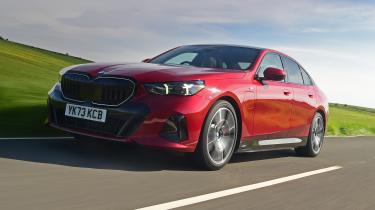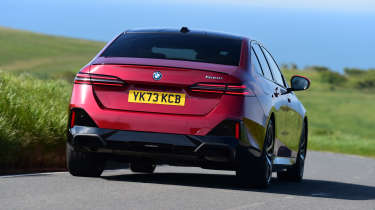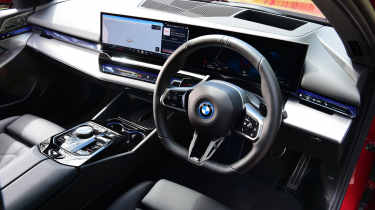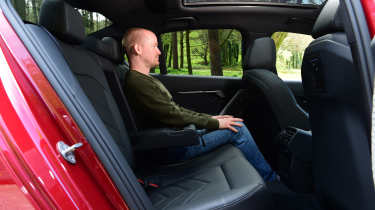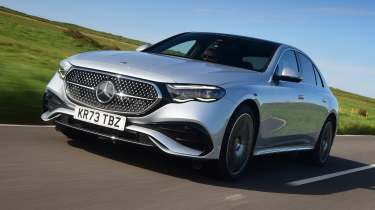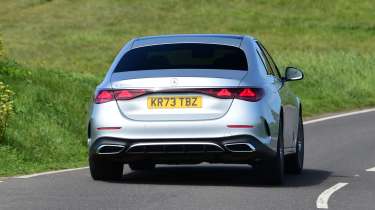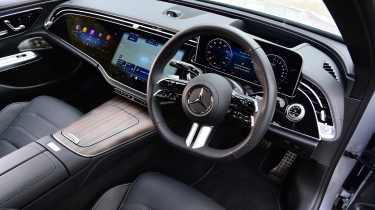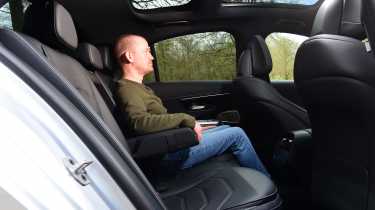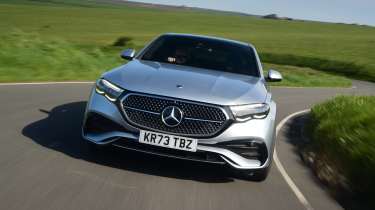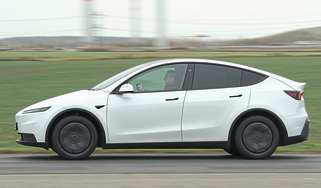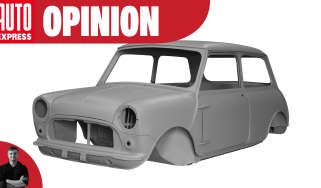BMW 5 Series vs Mercedes E-Class: which is the elite executive car?
We put the latest versions of these German rivals’ executive saloons to the test to discover which is the chairman of the board
“All the car you ever need.” It’s a phrase that is definitely bandied around too often. But we’re going to add one more usage of it here, because we can’t think of many cars that have the potential to fit that ambitious billing better than the two models facing off in this week’s Real-World Road Test.
In the Fire Red corner we have the BMW 5 Series. It’s in its eighth generation, and its maker promises that it’s more advanced, more refined and more complete than ever before. It’s also larger, which at least offers the potential to deliver limo-like levels of interior space.
In the High-Tech Silver corner is the new Mercedes E-Class which, like its rival, should move the game on across the board – no mean feat, considering how good the outgoing car was.
Our rivals have plug-in hybrid powertrains, which in theory allow them the potential to run much of their lives in zero tailpipe-emission mode, with the added flexibility of a petrol engine for longer runs.
| BMW 530e M Sport Pro | Mercedes E 300 e AMG Line Premium Plus | |
| Price: | £62,455 | £76,610 |
| Powertrain: | 2.0-litre 4cyl PHEV, 295bhp | 2.0-litre 4cyl PHEV, 309bhp |
| 0-62mph: | 6.3 seconds | 6.4 seconds |
| Test efficiency: | 50.6mpg/11.1mpl | 40.5mpg/8.9mpl |
| CO2: | 16g/km | 13g/km |
| Annual VED: | £570 | £570 |
BMW 5 Series
The 530e line-up starts from £59,455, but our M Sport Pro model costs £3,000 more. Thanks to a few select options, including the £3,300 Technology Plus Pack and striking Fire Red paint, the car in these pictures costs £72,875.
Tech highlights
What is clear from the off is that unlike some PHEVs, these rivals offer up as much go from the EV side of their powertrains as they do from the petrol element. The BMW’s Cluster Architecture was designed to accommodate traditional internal- combustion engines, fully electric powertrains, or a mix of the two. Here it really is a mix, with the two sides offering up almost identical outputs.
Used - available now

2022 Citroen
C3 Origin
21,299 milesManualPetrol1.2L
Cash £9,857
2023 MG
ZS
25,233 milesAutomaticPetrol1.0L
Cash £13,897
2023 Ford
Focus
47,039 milesManualPetrol1.0L
Cash £13,697
2026 Volkswagen
Taigo
37,397 milesManualPetrol1.0L
Cash £13,697The 530e’s 2.0-litre, four-cylinder engine makes 187bhp and 310Nm of torque, and while the electric motor is significantly more compact, it makes 181bhp and 250Nm. Thanks to a 19.4kWh (usable) battery located between the front and rear axles, there’s enough energy for 63 miles of fully electric range. When both elements combine, the total output comes to 295bhp and 450Nm. Drive is sent to the rear wheels via an eight-speed automatic gearbox, while a long hold of the left-hand steering wheel-mounted paddle shifter gives access to the full output in a 10-second burst – ideal for overtakes.
The 5 Series uses a conventional coil-spring set-up for its front suspension, with multi-link suspension at the rear suspended by air springs to provide a level ride height, regardless of the load.
Safety: The 5 Series range was awarded a five-star Euro NCAP rating when it was tested in 2023. As standard, it comes with plenty of active safety tech, including the Driving Assistant, whose camera and radar-based set-up combines adaptive cruise control and lane-keeping assist, plus lane-departure warning and speed-limit assist.
On the road
The eighth-generation 5 Series sets a new standard for handling in this class, yet combines this with superb comfort and refinement.
Around town: In EV mode, the 530e pulls away smoothly and offers up more than enough performance for everyday driving, while the throttle response is positive, so it doesn’t feel like you’re wanting for more speed. There’s just the slightest bit of low-speed fidget to the ride, but it’s far from what we’d call intrusive.
A & B-roads: Nobody expects a five metre-long, two-tonne saloon car to feel sharp to drive, but the 5 Series does a much better approximation of a driver’s car than the on-paper figures suggest. The sweetly balanced chassis offers plenty of grip, and body roll is kept well in check. The chassis doesn’t get flustered even with the sharp direction changes that the very light, quick steering makes possible.
We’d like a little more feedback from the latter, but it does a great job of hiding the car’s mass without allowing you to get too confident. The brakes are powerful, too, giving the driver lots of confidence when they do need to scrub some speed off. The 6.3-second 0-62mph time feels completely plausible, but with so much of that torque provided from the electric motor, the 530e builds its speed in a very smooth way.
Motorway: When the engine does come into play, it’s only audible from a fairly distant hum up front. It settles down at a cruise (if it’s on at all), which lets you appreciate just how little wind and road noise reach the cabin. The BMW remains steadfast in its high-speed stability, and any low-speed fidget is long gone, so the 530e makes for a brilliant long-distance cruiser.
Ownership
BMW has really got a handle on its modern interior design, and the 5 Series is one of the finest examples of it yet. Contemporary, hi-tech and beautifully finished, there’s little else for the money that feels as special. Yet all that would be meaningless if it wasn’t for the fact that it manages to remain functional and easy to use, too.
A key to the car’s solid ergonomics is the fact that its maker is one of the few brands that has maintained a physical control for making inputs on the touchscreen; this makes small adjustments on the move possible without having to divert your gaze away from the road. There are still one or two things that could be improved, though. For example, we find the touch-sensitive keys for the window heater and hazard-warning switch could be more sensitive, so you don’t need to jab them quite so firmly to get a response.
The front seats are superbly comfortable and both they and steering wheel have a huge range of adjustment. Device connectivity is excellent; outer rear-seat passengers get an extra USB-C port each with the optional Travel and Comfort system that is part of the £1,700 Comfort Pack; this also adds a powered tailgate and a heated steering wheel.
Buyers have high expectations of the ownership experience delivered by premium German cars, but the big three of BMW, Mercedes and Audi fail to live up to them. While BMW fares the best of the three, coming 21st out of 32 manufacturers surveyed in our 2023 Driver Power poll is still not a particularly impressive result.
Storage: A deep cubby under the central armrest is useful for hiding valuables, and the 5 Series also has a wireless charging pad just beneath the centre console. The USB-C ports are awkwardly positioned just ahead of the cup-holders, though. The door bins are wide and deep, so there’s space for a bulky water bottle to be safely stowed.
Practicality
The 530e is among the most spacious cars in this class, both for rear-seat passengers and when loading items into the boot.
Rear Space: The back seats feel as sumptuous as those up front, with even the central seat feeling like a relaxing place to sit – not always a given, even in a car this large. There’s loads of space, and headroom is especially impressive, but the wide, long cabin gives occupants lots of room to stretch out in all directions.
Boot: There isn’t any compromise on boot space in plug-in hybrid versions of the 5 Series, which means you get the same vast 520-litre load area that you do in the standard petrol model. If you need to carry longer items, then the rear-seat backs can drop down to expand that volume into the cabin, although the saloon bodystyle makes it tricky to load really bulky items.
What to buy?
Which version we’d choose…
- Powertrains: The new 5 Series range kicks off with the mild-hybrid 520i, which offers up 205bhp and more than adequate performance for most buyers. Starting from £51,015, it significantly undercuts the PHEVs. The 530e sits below the range-topping 550e xDrive, which gets a larger 3.0-litre straight-six engine and produces 483bhp.
- Trim: For petrol and PHEV models, the choice is between M Sport and M Sport Pro. The latter gets bigger wheels, a boot spoiler, M Sport seat-belt colours and an illuminated grille surround – mainly cosmetic changes that add to the cost.
- Our choice: We reckon the standard 530e M Sport is the one to have here.
Mercedes E-Class
The E 300 e we’re testing is in high-ranking AMG Line Premium Plus trim. At £76,610, it’s pricier than the BMW, but there are very few options to add to that, although this car’s Driving Assistance Package Plus lifts the cost to £78,305.
Tech highlights
On paper, these two cars have very similar PHEV powertrains. As with the 530e, the E 300 e uses a 2.0-litre turbocharged petrol engine boosted by a single electric motor to drive the rear wheels.
There are differences in output, though; while the 201bhp petrol engine in the Mercedes makes similar figures to the BMW’s (14bhp and 10Nm more), its 127bhp e-motor is 54bhp down, but compensates with a hefty 440Nm of torque – 190Nm more than in its rival. The combined result is a modest 14bhp power increase over the 5 Series, but 100Nm more torque. That last figure is important, because the 2,190kg Mercedes is 110kg heavier than the BMW.
At 19.5kWh, the usable capacity is pretty much identical to its rival’s, too, and the E 300 e’s gearbox has one extra ratio – nine versus eight. The E-Class comes with adaptive dampers on passive springs, while both test cars were fitted with the same Michelin E Primacy tyres in identical sizes.
Mercedes has pushed for aerodynamic efficiency in the E-Class’s development, and its drag coefficient of 0.23Cd is a match for the BMW’s. Side seals on the bonnet, a smooth underbody including suspension cladding, and retractable door handles that fit flush with the body when the car is moving (or locked) all aid the slippery shape.
Safety: The E-Class hasn’t been tested by Euro NCAP yet, but its standard blind-spot and lane-keep systems should help contribute to a high score when the new Mercedes is evaluated.
On the road
Comfort is the E 300 e’s strong point, with excellent ride and refinement at all speeds.
Around town: The first thing that strikes you about the E-Class is just how well it rides – even on the huge 20-inch wheels of our test car. It glides over many bumps that cause a little fidget in the BMW, which means that, regardless of speed, the E-Class is the more comfortable car of this pair.
A & B-roads: Find a more challenging section of road and the E-Class has a neutral balance, but there’s more roll through the corners than in the 5 Series, less overall grip, and a general feeling that it’s a little less agile. The very fast and light steering feels too quick for the body, which can struggle to keep up with more aggressive movements.
The Mercedes’ weight is most noticeable under braking, where the system fails to bring the car to a halt as urgently as the BMW’s. But it’s the feel that also causes issues; the left pedal is very soft during motor regeneration, and during more gentle stops tends to surge a little rather than engaging a smooth stop. The variable regeneration doesn’t offer equal steps between each level – two feel almost completely like freewheeling and another gives strong regen. Once the discs and pads begin to help out, pedal feel becomes much firmer, but this inconsistency doesn’t inspire confidence.
Motorway: The E-Class’s high-speed ride is also excellent, and the car is very stable. Both rivals are extremely hushed inside the cabin, and as with the BMW, the E 300 e’s engine is barely audible at 70mph. There’s nothing to separate them in terms of straight-line speed, whether in electric or hybrid mode. Officially the Mercedes takes 0.1 seconds longer from 0-62mph, at 6.4 seconds.
Ownership
The cabin of the E-Class initially appears like one huge, daunting tech-fest, with a dashboard that is constructed entirely from screens. The huge panel doesn’t leave much scope for design flair, so it’s not quite as interesting to look at as the BMW’s interior. But the neat detailing for the air vents, which appear to flow in one continuous curve around the dashboard, and the use of multi-colour ambient lighting, still make the cabin feel like an event.
Among the various leather and leather-effect materials, metallic trim and glossy displays, our car had a single piece of wood panelling beneath the main screen, which seemed a little out of place. The heavily perforated steering wheel feels good in the hands, and while some find the touch-sensitive controls on the four wheel spokes are a little fiddly, they’re grouped into specific functions, so it doesn’t take long to get familiar with the layout.
The dash line is a little lower than in the brand’s all-electric EQE and EQS, which makes the driving position more comfortable, but forward visibility still isn’t quite as good as in the 530e. A panoramic sunroof is standard on the AMG Line Premium Plus, which makes the cabin feel more airy.
Mercedes finished four places lower than BMW in our 2023 Driver Power customer-satisfaction survey, with a disappointing 25th position overall. Owners provided feedback on how reliable their cars had proved to be, and with 28 per cent of Mercedes owners experiencing a fault of some sort within the first year of ownership, the brand is less reliable than both BMW (22 per cent of owners experienced faults) and Audi (23 per cent).
Storage: Like the BMW, the E-Class has a storage bin beneath the front central armrest, but here it’s even deeper and larger than in its rival. Another large closed storage area further ahead has space for a pair of cup-holders and the wireless smartphone-charging pad.
Practicality
The E-Class is very spacious inside for passengers, but unlike in the BMW, the plug-in hybrid tech impacts boot space.
Rear Space: Both of these cars are huge in the back, with tiny margins separating them; the E-Class just beats its rival for kneeroom, but loses out very slightly when it comes to headroom.
Fitting a child seat in the Mercedes is straightforward, because the ISOFIX mounts are easy to reach behind rubber flaps. Those in the BMW are accessible, too, thanks to the plastic mountings.
Boot: At 370 litres, the E 300 e’s boot volume is a bit disappointing for a car of this size; capacity is compromised by the hybrid tech, so the figure is 170 litres less than for a petrol or diesel E-Class. There’s no underfloor storage for housing the charge cables, either, so they will take up a chunk of that reduced load space.
What to buy?
Which version we’d choose…
- Powertrains: Unlike the BMW, the Mercedes is available with a mild-hybrid diesel engine. The E 220 d offers a 7.6-second 0-62mph time and an official fuel-economy figure of 58.9mpg. The E 300 de also offers buyers the choice of a plug-in hybrid option with a more frugal diesel element.
- Trim: The E 300 e is offered in four spec levels. The range kicks off with the £64,610 Urban Edition (for the E 300 e and E 300 de only), the AMG Line Premium and Exclusive Premium both cost £69,610, while the AMG Line Premium Plus tops the range at £76,610.
- Our choice: The standard AMG Line Premium offers the ideal package.
Results
Which car comes out on top?
Winner: BMW 5 Series
When one of the few points of contention we can find is that the lower model in the range is likely to be all the car that most buyers really need, it hammers home just what a brilliant all-rounder the latest BMW 5 Series really is.
Performance, refinement, practicality and technology all take a giant leap beyond what was on offer in its predecessor and, the slightest firmness to the low-speed ride aside, the new 5 Series is supremely comfortable and wonderfully refined, too.
| Pros | Cons |
| Handling | Low-speed ride |
| Refinement | Too few physical controls |
| Space | Digital dials look a bit fussy |
| Interior design and finish | 520i is much cheaper |
Runner-up: Mercedes E-Class
It may have to settle for second place here, but the latest E-Class is the most complete version Mercedes has produced yet.
Comfort and refinement are both remarkable, while the huge EV range means that many buyers of this PHEV model will use the petrol engine so infrequently that they’ll forget just how smooth it is.
The flaws that we’ve highlighted are minor, but against such a talented rival, they’re enough to be a deal breaker – as are the high monthly payments.
| Pros | Cons |
| Superb ride comfort | Inconsistent brakes |
| Packed with equipment | Feels heavy to drive |
| Long electric range | Boot space |
| Hushed cabin refinement | Oppressively large screens |
Rivals and other options
The Scala wins our test, but what else is out there?
- Same class: Range Rover Velar
- Same class: Jaguar XF
- Used: BMW 5 Series (G30/G31)
- Used: Porsche Taycan
- Coming soon: Audi A6/A7
The great debate
The Auto Express team have their say…
John McIlroy, editor-at-large: “We don’t think that many buyers will need more performance from their PHEV than the 530e offers, but a range-topping 550e fits just that bill. A straight-six petrol engine and a marginally more potent electric motor deliver 483bhp and 700Nm – good for a 4.3-second 0-62mph time.”
Richard Ingram, deputy editor: “While the battle is close when an internal-combustion engine is on the table, the gap between BMW and Mercedes grows much wider with EV powertrains. The 5 Series is arguably at its best as the all-electric i5, but the EQE is a letdown, failing to live up to the E 300 e’s high standards.”
Dawn Grant, picture editor: “This pair have the potential to push the boundaries of taste with their grilles. Both the BMW’s huge kidney grilles and the Merc’s fascia, adorned with mini three-pointed stars, are available with
a glowing surround to make them even more distinctive in low light. Definitely an acquired taste.”
Paul Barker, editor: “BMW really is on a roll right now. Pretty much across the board, it offers a car that’s towards the top – if not at the very top – of its class. We’re excited to see where it’ll head next, because in quite a few areas of the market it’ll be hard for BMW to top what it’s already doing.”
Dean Gibson, senior test editor: “If you need more space, then both of these cars are offered in estate form. As with the E 300 e saloon, the Merc’s boot is compromised by the PHEV gubbins below, leaving a huge step in the floor. The 530e Touring’s 570-litre boot beats its rival’s by a full 110 litres.”
Which would you buy? Let us know in the comments section below…
Specs and prices
| BMW 530e M Sport Pro | Mercedes E 300 e AMG Line Premium Plus | |
| On the road price/total as tested: | £62,455/£72,875 | £76,610/£78,305 |
| Residual value (after 3yrs/36,000): | £30,122 (48.23%) | £35,340 (46.13%) |
| Depreciation: | £32,333 | £41,270 |
| Annual tax liability std/higher rate: | £998.40/£1,996.80 | £1,224.88/£2,449.80 |
| Annual fuel cost (10k/20k miles): | £1,343 (£2,686) | £1,678 (£3,356) |
| Ins. group/quote/VED: | 40/£1,117/£570 | 50/£844/£570 |
| Length/wheelbase | 5,060/2,995mm | 4,949/2,961mm |
| Height/width | 1,515/1,900mm | 1,480/1,880mm |
| Powertrain | 4cyl in turbo, 1,998cc/e-motor | 4cyl in turbo/1,999cc/e-motor |
| Engine power/torque | 187bhp/310Nm | 201bhp/320Nm |
| Electric motor power/torque | 181bhp/250NM | 127bhp/440Nm |
| Combined power/torque | 295bhp/450Nm | 309bhp/550Nm |
| Transmission | Eight-speed auto/rwd | Nine-speed auto/rwd |
| Fuel tank/battery capacity | 60 litres/19.4kWh | 50 litres/19.5kWh |
| Boot capacity | 520 litres | 370 litres |
| Kerbweight/payload/towing weight | 2,080/650/1,800kg | 2,190/615/2,100kg |
| Turning circle | 11.9 metres | 11.6 metres |
| Basic warranty/recovery | 3yrs (unlimited)/3 yrs | 3 yrs (unlimited)/Up to 30 yrs |
| Driver Power manufacturer position | 21st | 25th |
| Euro NCAP: Adult/child/ped./assist/stars | 89/85/86/78/5 | N/A |
| 0-62mph/top speed | 6.3 seconds/143mph | 6.4 seconds/147mph |
| Test economy/range | 50.6/668 | 40.5/445 |
| WLTP combined | 403.5mpg | 470.9mpg |
| Pure-electric range (WLTP) | 61 miles | 65 miles |
| Charging time | 3hrs 15mins (7.4kW) | 2hrs (11kW) |
| Actual/Claimed CO2/tax bracket | 129/16g/m | 161/13g/km |
| Number of airbags/Isofix points | Nine/two | Eight/two |
| Parking sensors/camera | F&r/360 | F&r/yes |
| Lane-keep assist/blindspot/AEB | Yes/yes/yes | Yes/no/yes |
| Climate control/adaptive cruise | Dual-zone/yes | Three-zone/yes |
| Leather/heated seats/wheel | Faux/yes/£1,700* | Yes/yes/yes |
| Metallic paint/LED lights | £900/yes | £0/yes |
| Keyless entry & go/powered tailgate | Yes/£1,700* | Yes/no |
| Sat-nav/digital dashboard/USBs | Yes/yes/four | Yes/yes/six |
| Online services/wireless charging | Yes/yes | Yes/yes |
| Wireless Apple CarPlay/Android Auto | Yes/yes | Yes/yes |


